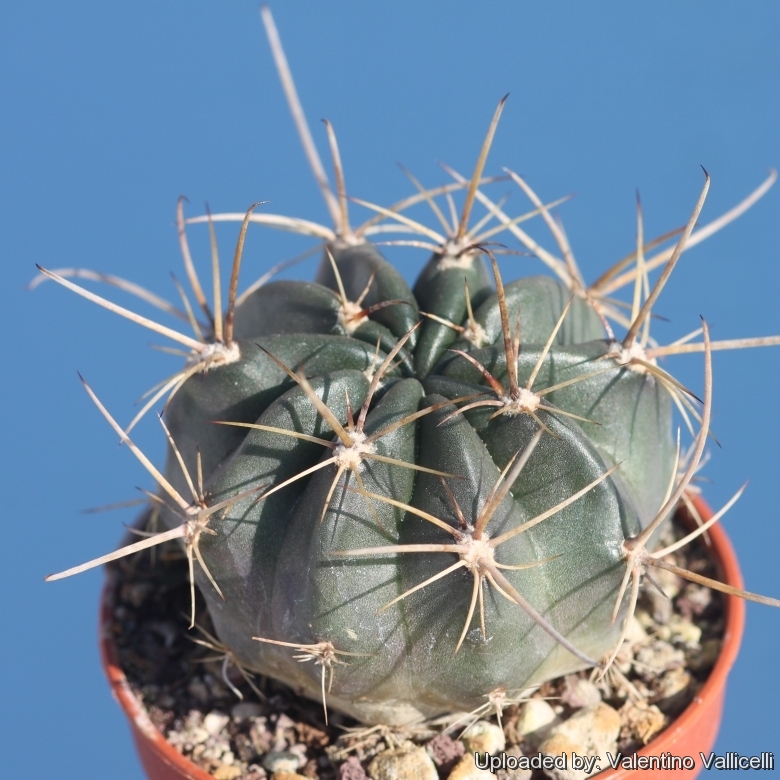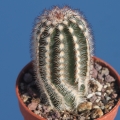Accepted Scientific Name: Echinopsis chrysochete Werderm.
Repert. Spec. Nov. Regni Veg. 39: 271. 1936 ( "chrysochele" )

Lobivia chrysochete var. tenuispina Photo by: Valentino Vallicelli
Origin and Habitat: Origin and Habitat: Deeper regions around Iscayachi, Mendez, Tarija, Higher Andes of Bolivia.
Altitude ranges: 3300-4000 metres above sea level.
Habitat and ecology: Lobivia chrysocheteSN|21125]]SN|21125]] var. tenuispina grows on rocky outcrops facing south or east and flat areas.
Synonyms:
See all synonyms of Echinopsis chrysochete
back
Accepted name in llifle Database:Echinopsis chrysochete Werderm.Repert. Spec. Nov. Regni Veg. 39: 271. 1936 ( "chrysochele" )Synonymy: 10
back
Description: Lobivia chrysocheteSN|21125]]SN|21125]] var. tenuispina is one of the many geographical or morphological form of Echinopsis chrysocheteSN|21124]]SN|21124]]. Many variant of Echinopsis chrysocheteSN|21124]]SN|21124]] was early classified as different independent species, but nowadays all this plants are considered part of a multiform species, where each form is linked to others by populations of plants with intermediate characteristics. L. chrysochete var. tenuispina shows darker dense spination and colourful golden yellow flowers.
Stems: Solitary (sometime forming few branched clumps), flattened globose to globose. (but often taller and less flattened in cultivation) green, and up to 25 cm broad.
Ribs: About 20, with chin shaped humps.
Central spines: 3 to 5 thin, 6-8 cm long, needle-like bristly, yellow to brownish.
Radial: Numerous (20-30) similar in colour to the central spines.
Flowers: 3-4 cm in diameter, widely funnelform, yellow or orangish with lots of shiny petals aranged almost like a marigold.
Bibliography: Major references and further lectures
1) Walter Rausch “Lobivia: The Day Flowering Echinopsidinae from a Geographical Distribution Point of View” Vol. 1-3 R. Herzig, 1975
2) David Hunt, Nigel Taylor “The New Cactus Lexicon” DH Books, 2006 ISBN 0953813444, 9780953813445
3) Edward F. Anderson “The Cactus Family” Timber Press, 2001
Cultivation and Propagation: Echinopsis chrysocheteSN|21124]]SN|21124]] var. tenuispina is an easy to grow succulent, more cold tolerant than most and less fussy regarding soil conditions.
Growth rate: It is a relatively rapidly growing and easily flowering species that will make smzsl clumps given the best conditions.
Soils: It likes very porous standard cactus mix soil.
Repotting: Use pot with good drainage.
Watering: Water regularly in summer, but do not overwater (Rot prone), keep dry in winter.
Fertilization: Feed with a high potassium fertilizer in summer.
Hardiness: Reputedly somewhat resistant to frost if kept on the dry side prior to, and during, cold weather (hardy to -12 C ° C, or less for short periods).
Exposition: Outside bright sunlight or afternoon shade, inside it needs bright light, and some direct sun. Tends to bronze in strong light, which encourages flowering and heavy spine production.
Uses: It is an excellent plant for container growing. It always looks good and stays small. It look fine in a cold greenhouse and frame or outdoor in a rockery.
Pests & diseases: It may be attractive to a variety of insects, but plants in good condition should be nearly pest-free, particularly if they are grown in a mineral potting-mix, with good exposure and ventilation. Nonetheless, there are several pests to watch for:
- Red spiders: they may be effectively rubbed up by misting the vulnerable plants every day.
- Mealy bugs: occasionally they develop aerial into the new growth among the wool with disfiguring results, but the worst types develop underground on the roots and are invisible except by their effects.
- Scales: they are rarely a problem.
It is wise to treat your whole collection with a systemic insecticide twice a year in spring and autumn.
- Rot: it is only a minor problem with cacti if the plants are watered and “aired” correctly. If they are not, fungicides won't help all that much.
Propagation: Division, direct sow after last frost. Seeds germinate in 7-14 days at 21-27° C in spring, remove gradually the glass cover as soon the plants will be well rooted (ca 1-2 weeks) and keep ventilated, no full sun for young plants! To make a cutting twist off a branch and permit it to dry out a couple of weeks, lay it on the soil and insert the stem end partially into the soil. Try to keep the cutting somewhat upright so that the roots are able to grow downward.
Your Photos

by Valentino Vallicelli











